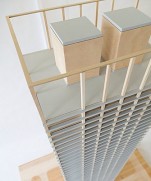Timber Tower

What is a skyscraper? It is a tall building of glass, steel and concrete, built with the most modern materials and technologies. But more often heard seemingly incongruous words - “wooden skyscraper.” In some countries already constructed or are being erected the buildings made of wood up to 30 floors height, and in international competitions are increasingly represented projects of high-rise buildings with timber frame.
The ideas to create such structures arise from the need to improve the ecological state of the environment, energy saving and scavenging the air of carbon dioxide. Such buildings reduce the negative impact on the environment, and wooden structures serve as a good substitute for expensive standard building materials, which production requires a lot of energy. The project of a tall building made of wood was also offered by the famous architectural firm Skidmore, Owings & Merrill (SOM).
Global Sustainability Problems
Global population has doubled since 1950 and is projected to continue rapid growth, surpassing 11 billion by 2050. Current built environments do not have the building and infrastructure capacity to support this growth. At the same time, Greenhouse Gas emissions continue to increase around the globe. However, when GHG emission levels of dense urban environments are compared to national GHG averages, the urban environments have drastically lower levels.
How and where we choose to build is of great consequence. Global population has doubled since 1950 and is projected to continue rapid growth, surpassing 11 billion by 2050.
Actually, many metropolitan areas are less dense than they were in 1950 because, even though global population has substantially increased, the amount of land occupied by cities and their exurbs has expanded even faster. Together, population and built environment growth has spurred many negative environmental impacts, including inefficient land, transportation, and energy usage. If left unchecked, these effects will continue to degrade the environment at an accelerated pace. Continuing to develop dense urban environments characterized by tall buildings will help mitigate both issues of population and environmental sustainability, but only if the development is done responsibly.
Tall buildings organized into dense, livable environments can help curb these problems, but they aren’t a perfect solution. Their embodied carbon footprints, the startup carbon cost to build the building, are significantly higher relative to low-rise buildings on a per square foot basis. This is because the structure is usually responsible for the majority of each building’s embodied carbon footprint, and tall buildings require far more structure to support their height. Still, building more tall buildings at an urban density would significantly help serve future environmental and population needs – the sustainable solution lies in developing tall building structural systems that minimize embodied carbon footprints.
At SOM this system takes the form of Timber Tower. Timber Tower uses mass timber as its main structural material. Supplementary reinforced concrete supports the structure’s highly stressed connecting joints. The result is believed to be an efficient structure that could compete with reinforced concrete and structural steel systems while reducing the building’s embodied carbon footprint by 60 to 75%.
Full content of this issue you can read here
The full version of the article can be read in our printed issue, also you can subscribe to the web-version of the magazine
 Materials provided by Skidmore, Owings & Merrill LLP (SOM)
Materials provided by Skidmore, Owings & Merrill LLP (SOM)


